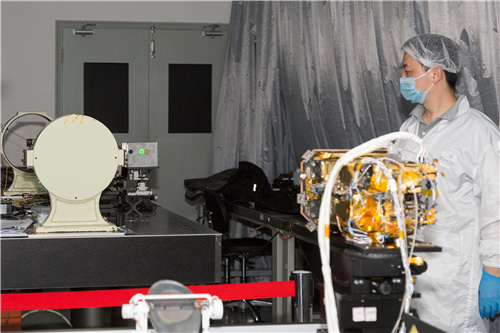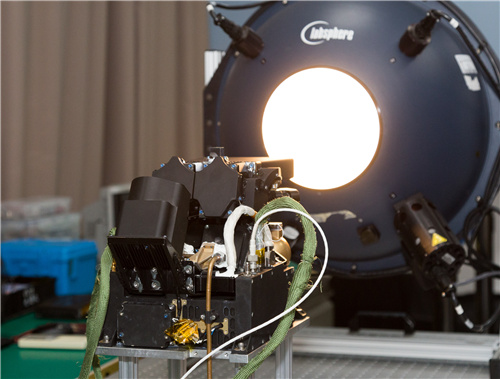On June 11, the National Space Administration announced the first batch of scientific images taken by the "Zhurong" Mars rover, marking the complete success of my country's first Mars exploration mission. On this Mars rover, it is equipped with a scientific payload-the Martian surface composition detector, developed by the Shanghai Institute of Technical Physics of the Chinese Academy of Sciences (hereinafter referred to as Shanghai Institute of Technology).
In addition to the Mars surface composition detector, the Shanghai Institute of Technology is also responsible for the development of the Mars mineral spectrum analyzer on the Mars orbiter, making the institute the only scientific research institution that undertakes the development of two payloads.

Shu Rong, deputy director of the Shanghai Institute of Technology and the load commander of the lunar and deep space exploration series, introduced that the Mars surface composition detector will carry out high-precision scientific detection of the elements, minerals and rocks on the Martian surface in the landing zone. "On June 4 Powered on, and successfully downloaded the first set of data on the 5th." The Mars mineral spectrometer was turned on on February 28, and it has conducted multiple surveys of pre-selected landing areas.
According to the statistics of a reporter from China Science Daily, the Shanghai Institute of Technology has created a series of "firsts" in order to better complete this Mars exploration mission.

Anticipation and tension at the moment of "real gun combat"
Before the start of the Mars surface composition detector, Shu Rong's team was worried about whether it was in good condition and whether it could be "obedient" after the "Zhu Rong" rover went through a long journey... Before the data was successfully downloaded, they were worried about the data. Is the process of returning smooth...
In fact, Shu Rong's team has conducted countless simulation experiments in the early stage, but when "real guns are in action", it is difficult to conceal inner tension and expectations.
In fact, the moment when the "Zhurong" rover landed was their most tense period. According to statistics, the success rate of the rover successfully landing on the surface of Mars is only 50%. Even if the rover successfully landed, what is the state of the Martian surface composition detector after the thermal shock during the fall of the fire? Can the detector attached to the outer side of the rover and weighing more than 1/2 of the rover’s load withstand the test of the large temperature difference between day and night on Mars?
The answer was announced on June 4. On the same day, the Mars surface composition detector was turned on normally and the first set of data was successfully downloaded the next day. The Shu Rong team members were extremely excited and excited.
"After powering on, the detector calibrated the titanium sample plate and probed the Martian rocks near the'Zhurong' rover." Shu Rong said that the current detector's telemetry data is normal and its working condition is stable.
2.5 to 3.4 micron hyperspectral, capable of detecting water molecules
The Tianwen-1's analysis of the pre-selected landing area requires the help of loads such as the Martian mineral spectrum analyzer. "Before landing, the scientific data obtained by the Mars mineral spectrum analyzer can help determine the mineral composition and distribution in the landing zone." He Zhiping, a researcher at the Shanghai Institute of Technology and the chief designer of the Mars mineral spectrum analyzer, introduced that day. After Q1 entered the ring fire orbit, the analyzer was turned on for the first time on February 28.
Subsequently, the Mars mineral spectrum analyzer was turned on several times and successfully obtained scientific data, which contributed to leaving a "Chinese mark" on Mars.
The reporter of "China Science Daily" learned that this payload has internationally advanced spectral detection capabilities, with a spectral detection range of 0.378 micrometers to 3.425 micrometers, and a detection spectrum of up to 576. "Especially the 2.5-3.4 micron hyperspectral detection is my country's first space verification application." In He Zhiping's view, this spectrum is of great value and has the ability to detect water molecules.
He further explained that in the past space-to-earth exploration missions, because the above-mentioned spectrum was absorbed by the earth’s atmosphere, this spectrum has never been used for earth remote sensing observations.
In the detection of the Martian mineral spectrum analyzer in the 1 micron to 3.4 micron spectrum, the mercury cadmium telluride detector needs to withstand the test of the temperature difference of 200 ℃. "It's like throwing the instrument into the stove, then throwing it into the ice cubes, and it goes back and forth." Said Zhou Songmin, an associate researcher at the Shanghai Institute of Technology and the chief designer of the infrared array detector of the Mars Mineral Spectrum Analyzer.
According to design requirements, researchers need to carry out 500 cycle life tests, but in order to better adapt to the Martian environment of "ice and fire", they conducted as many as 2,000 tests on the ground.
However, the Martian mineral spectrometer has not yet officially launched a scientific exploration mission. "Subsequently, the analyzer did not officially work until Q1 entered the scientific exploration orbit that day." He Zhiping said that they also expected more discoveries from the analyzer.